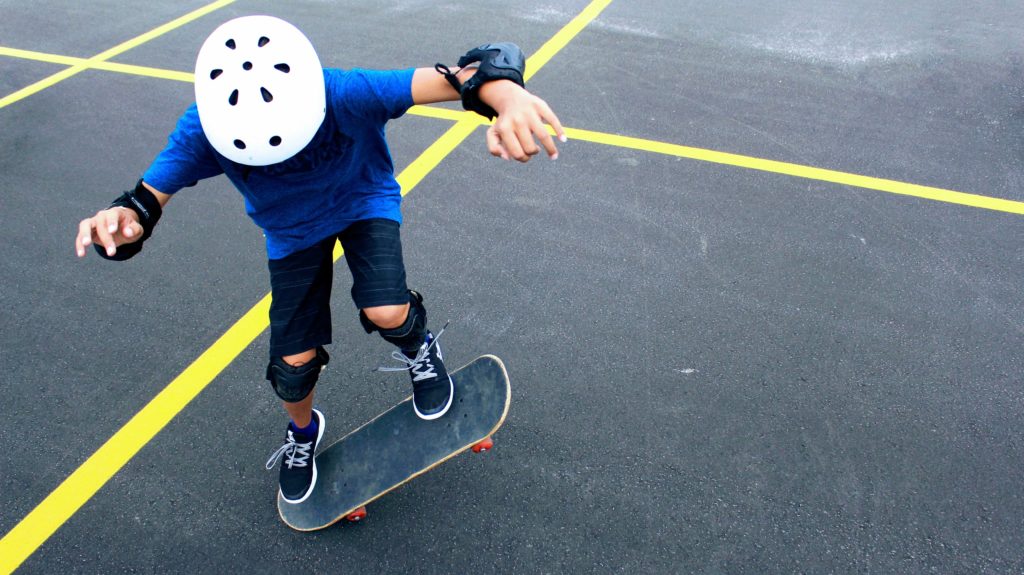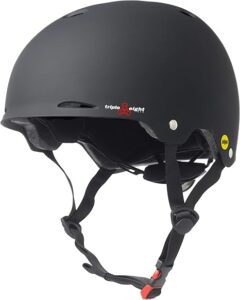
(Updated January 2020)
While analyzing skateboard safety statistics, it’s hard to ignore that part of learning how to skateboard is the part where you fall a lot. Injuries are not ideal but you should know the risks as you or your kids learn how to skateboard.
You can reduce the risk of a skateboarding injury by wearing the proper skateboard equipment, practicing continuously, and staying in good physical condition.
But not every injury is preventable. It’s good to know just how risky skateboarding is so you know what to prepare for and how to handle an injury should it happen to you or in your presence. You’ll learn just how important it is to wear proper safety gear when skateboarding, especially as a beginner. You don’t want to become one of these skateboard injury statistics if you don’t have to!
Skateboarding Sport Statistics
For skateboarding enthusiasts, the exciting news is that skateboarding will be making its debut in the 2020 Summer Olympics in Tokyo and the United States will be sending a team.
Invented in the late 1940s, skateboarding has become a multi-billion dollar industry. The sport is popular and often considered extreme because of the nature of some of the injuries that riders incur. Parents see a broken wrist as an awful injury for their child. Its popularity may seem to be dropping, but skateboarding is still considered to be among the 10 most popular sports globally.
However, even though the most common injuries include broken wrists, twisted knees, and rolled ankles there are other sports that are deemed more dangerous by the U.S National Safety Council (pictured below). This is due to the nature of the injuries of other sports–head injuries and knee and back injuries are much more common in other sports–and due to the hard falls that parents see when their children fall. Many of these end up being minor injuries.

As a parent or as someone just beginning a new sport, it’s important to know what kind of risks you or your kids are taking. Each sport includes risk–even playground equipment. When you know the risks, you can plan better for them.
Skateboarding Injuries Compared to Other Sports
When it comes to injuries skateboarding gets the eighth place and seems to be less menacing than most people think. The first three positions are taken up by football, cycling and basketball. Many studies have disproved the danger of skateboarding compared to other sports, citing that many injuries are minor and easily treatable. There is certainly risk in skateboarding but you can be safer by avoiding large ramps, downhills, and wearing proper safety gear–especially young and inexperienced skateboarders.

Skate parks are being built around the world to fulfill the needs of the skateboarding population, which was estimated at 20 million internationally in 2009. More than half of these are in the U.S. and it is estimated that 45% are younger than 18. However, it appears that skateboard sales have been dropping by 2% per year since 2007, and the skateboarders are getting older. In 2006, 71% of skateboarders were younger than 18.
Skateboarding Compared to Baseball
Many of the less popular sports see cycles of success and that is why you will often see the number of injuries jump up and down over a 5-year period. They will also change seasonally. We know that baseball season usually occurs in the spring in summer while skiing and snowboarding are only played in the winter.
For instance, youth baseball had the same amount of interest at the peak of 2005 and 2014. This means that a similar number of parents and kids showed interest in the sport that year. However, in between those years, baseball was the most popular it’s been in the last 20 years. After that period, baseball experienced a drop off and was not nearly as popular.
This means that we it’s likely the total number of injuries from baseball decreased in the United States after the interest dropped. That does not mean that baseball becomes more or less safe compared to other sports like skateboarding. We have to look at the injury rate over time to find that.
Shown in the charts well above, we can see that skateboarding has an estimated lower rate of injury than many of the most popular sports in the United States: football, baseball/softball, basketball, and soccer. It even has a lower rate of injury than playground equipment.
We must also consider that not all injuries get reported. We must use our critical thinking to make sure our children are safe in everything they choose to participate in.
Latest Skateboard Injury Statistics
Interestingly, even though many reports speak about how dangerous the skateboarding can be, trying to find data and statistics that are up-to-date is almost impossible. It does appear from sales of protection gear that the majority of skateboarders do wear the appropriate gear when they ride.
What we could glean from various studies are the following:
- The number of skateboarder deaths between 2011 and 2015 in the U.S. was 147 and almost all of these happened on the road. (Source: Journal of Transport and Health)
- These fatality rates are the same as those for pedestrians. (Source: pedestrian & traffic fatalities, Department of Transportation, 2008 – 2017)
- Skateboarders travel at a slower speed than cyclists, but three times faster than pedestrians.
- 125,145 skateboarder injuries were attended to in the emergency departments of hospitals in 2015, according to the National Safety Council.
- According to the 2017 statistics issued by Injury Facts in 2017, almost half of these injuries involved the age groups 14 – 24.
- 74% of all injuries are to the extremities – 19 % entail broken wrists, 11% are injuries to the ankles, 16% to the face.
- Other common injuries are long bone fractures.
- 20% of all injuries are to the head and a higher proportion of head injuries occur to skateboarders who are under 10 years old.
- Serious head injuries include concussion, skull fractures, blunt trauma and closed head injuries and represent 3.1% of all injuries.
- One-third of injuries affect newcomers but even experienced skateboarders are not immune to the odd tumble and fall.
- Only about 5% of skateboarding injuries are severe and most of these occur from an accident involving a vehicle.
On the topic of skateboarding deaths, there should be serious discussion. The risk of dying while skateboarding is close to zero in a skate park. That is not the case when riding in the road. Please be safe if you choose to ride on the road, taking precautions in how you ride, what you wear, and the other vehicles around you. As a skater, cyclist, or pedestrian, there will always be risks around motor vehicles.
Always wear safety gear while riding. These are helmets meet we found to meet independent safety requirements. Always verify if those safety requirements meet your own threshold for safety before wearing them.


Typical Skateboard Injuries
According to the American Academy of Orthopedic Surgeons the injuries that they see the most correspond with the other statistics available. They report that the most common are cuts and bruises, sprains, and broken bones. Wrist fractures are a very common injury but wrist guards have been proven to be a great means of protection. Facial injuries are also very common among skateboarders and include broken noses and jawbones. The more severe types of injuries include head injuries such as concussion and others.
They report that they see 70,000 injuries in the emergency departments of hospitals every year. They urge skateboarders and parents of young budding skateboarders to select the places where they practice their sport carefully and to always wear protective gear.
Awareness and caution can help prevent many of the more serious injuries and most importantly fatalities.
Lastly, it’s important to realize that injuries happen all the time. We can only prepare for so much. There are plenty of sports that result in injuries that you would not expect, according to data from the NSC reports above: fishing among them. While there is a lower rate of occurrence in fishing, golf, and volleyball, the risk of injury is always there.
That’s why it is important to understand what these skateboard safety statistics tell us: wear proper skateboard safety gear, don’t ride on the ride in busy traffic, learn the basics of stopping before moving on to advanced terrain, stay in good physical shape, and know what to do when an emergency situation arises.
And have fun learning how to skateboard!